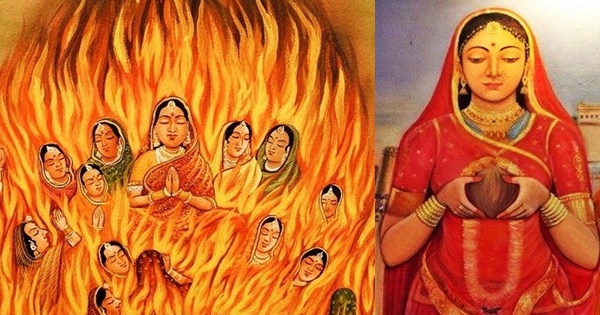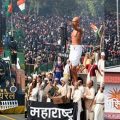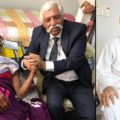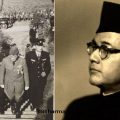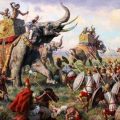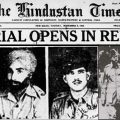Were INA Men Deserters and Oath Breakers? No! Here’s the True Story
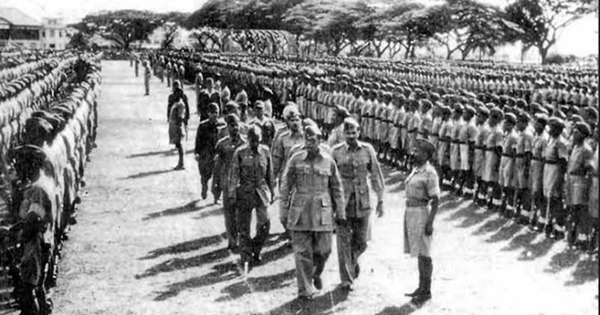
Ever since the British established their supremacy, there were revolts time and again across the country. There have been many unrecorded incidents of martyrdom; hence, it is impossible to count the exact figures. Millions attained martyrdom, while names of counted few are glorified in our history books. And we are made to believe that Mahatma Gandhi got us freedom through non-violence. As the narrative as been set in favor of Gandhi, lakhs of other freedom fighters are ignored.
What ultimately led the British hurriedly leave India? British archival records, as presented and quoted by Maj Gen GD Bakshi in two of his books, Bose: The Indian Samurai and BOSE or GANDHI : Who Got India Her Freedom?, reveal that the British left India because of Netaji and the INA trials. In the words of Clement Richard Attlee, who was the British Prime Minister from 1945 and 1951 and who signed off on the decision to grant Independence to India, Gandhi’s role in India’s freedom movement was ‘M-I-N-M-M-A-L’.
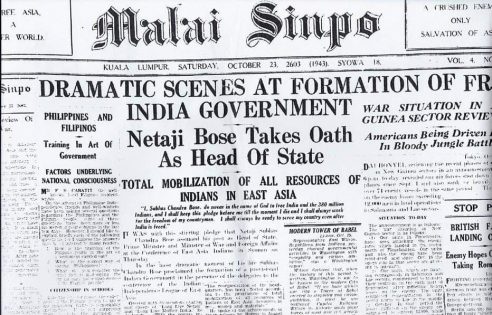
A 1943 Kuala Lumpur news report on the formation of the Azad Hind Govt. by Netaji Bose. Courtesy: Son of a soldier in Azad Hind Fauz
Why were INA men termed deserters and oath breakers by a particular section of Indians? Netaji Bose established the Provisional Government of Free India, i.e. Azad Hind Govt. in Singapore on 21 October 1943. Its army was the Azad Hind Fauj. It was recognized by 11 countries including Russia. Azad Hind Fauz declared war against Great Britain and duly sworn in the men of the INA a new Oath of Loyalty. So INA men were termed deserters and oath breakers because they were loyal to the INA Oath and not the British?
According to an India Today report titled “Netaji’s declassified files trigger ‘War Criminal’ row, show Nehru in bad light”, as quoted here – “Among the 100 classified Netaji Subhas Chandra Bose files released by Prime Minister Narendra Modi on the freedom fighter’s 119th birth anniversary is one file that examines a question about whether the patriot, who raised an army to fight the British, was ever a war criminal….The theory that Netaji had been declared a war criminal surfaced once again during the Khosla Commission of Inquiry in 1971 that probed the disappearance of the freedom` fighter. One important deposition was one of Shyam Lal Jain, Pandit Nehru’s stenographer, who claimed to have taken down a dictation from Nehru in December 1945. Jain claimed that the letter was addressed to then British Prime Minister Clement Atlee. The deposition of Shyam Lal Jain finds mention in the declassified file ‘Disappearance/Death of Netaji Subhas Chandra Bose 915/11/C/6/96-Pol’ from the Prime Minister’s Office. This file encloses a 10-page explanatory note on Netaji by author Pradip Bose, in which the reproduces Jain’s recollection of the letter that Nehru purportedly wrote to Atlee. ‘I understand from a reliable source that Subhas Chandra Bose, your war criminal, has been allowed to enter Russian territory by Stalin. This is clear treachery and a betrayal of faith by the Russians. As Russia has been an ally of the British-Americans, it should not have been done. Please take note of it and do as you consider proper and fit.’” In this report, Nehru’s letter terming Subhas Chandra Bose as ‘war criminal’ raises questions as to how an Indian can consider a fellow Indian fighting for the country’s independence as ‘war criminal’. This proves Nehru was a British stooge.
In between November 1945 and May 1946, the British held 10 court-martial trials of soldiers of the INA at Red Fort. A number of officers of the Azad Hind Fauz were considered guilty. Most of the soldiers who were tried were British prisoners of War who joined Netaji’s INA. The joint court-martial of Colonel Prem Sahgal, Colonel Gurbaksh Singh Dhillon, and Major General Shah Nawaz Khan, who were officers in the British Indian Army and taken as prisoners of war, and who joined the INA, drew sympathy from Indian soldiers posted in the British Army. The British charged them for ‘waging war against the King-Emperor’. There was huge outcry and unrest amid the Indian troops. The outrage led the British reduce the charges against the guilty.
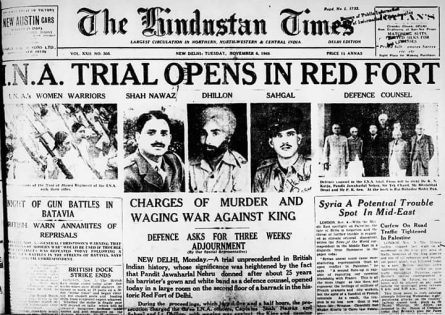
INA Trials news; Image courtesy: Twitter
Is it because the INA men waged War against the British King-Emperor that they were termed deserters and oath breakers? Is it because of this that they were declared war criminals on record even after Independence? Is it because of this that they were not taken back to the Indian Army at the advice of Nehru, who was further advised by Lord Mountbatten? This action of Nehru govt. led to many surviving INA veterans live and die in penury and obscurity after Independence. There are only a few surviving INA veterans. Maj Gen GD Bakshi has been demanding the Govt that the handful of surviving INA veterans be brought to Rajpath on Republic Day parade so that they get their due honor.
In the words of Maj Gen GD Bakshi in this regard, “This issue was put to the legal test in the INA trials when these officers and men were charged with Waging war against the king and breaking their Oath. These charges could not stand legal scrutiny. Let me explain. The Azad hind Govt had been duly established by Law – had been recognised by 11 Countries and had declared war on great Britain. The soldiers of INA had sworn an Oath to Azad Hind govt and their own country. That oath superseded his oath to an illegal colonial govt.”
“Are you telling me that all our Officers who had taken the oath to the British were still required to be loyal to the British even after 1947? Why were the Japanese the enemy? They were helping us get freedom. My enemy’s enemy is my friend is Chanakya Niti. Before you show such great loyalty to the Brtish please read how they callously and deliberately let 4 Million Indians starve to death in Bengal while grain was shipped to their Soldiers. That amounted to Genocide and it wasn’t the only famine in British india. You still want to bootlick the Brits as many of our predecessors did – that’s your choice. But please immigrate to Britain before you do that. Not on Indian Soil please – we have surfeit of traitors.”
Only a daring and brave son of Bharat Mata could undertake such death-defying journeys, moving from one country to another, until he could find a safe haven where he could gather forces to wage war against British. It was only Netaji Bose who could motivate Indians settled abroad, organize a force of 60,000 soldiers, and collect funds for the cause.
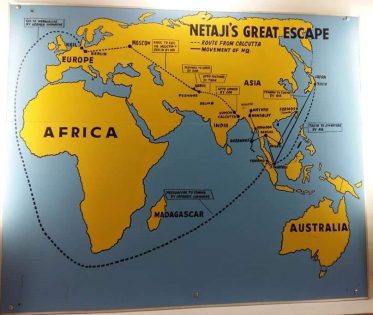
Image courtesy: @CorrectHistory (Facebook)
Why did Netaji escape from India and when? Netaji Bose was the President of the Indian National Congress in 1938 and 1939. But his ideologies did not match with Mahatma Gandhi and the Congress high command. Bose believed that it was only by using arms that the British could be driven out of India. Ultimately, he was ousted from Congress leadership in 1939 due to this ideological difference.
Lord Linlithgow was the British Viceroy of India when the Second World War broke out on September 3, 1939. On the same day, Lord Linlithgow declared India as belligerent and at war. The Congress and Muslim League supported the British on this decision which led to deployment of lakhs of Indian soldiers to fight in the War under British.
Netaji Bose advocated a mass civil disobedience campaign, to protest against the Viceroy’s decision. His strategy wasn’t supported by Mahatma Gandhi and the Congress high command. Thereafter, Netaji Bose organised mass protests in Calcutta calling for the ‘Holwell Monument’ stationed at Dalhousie Square to be removed. ‘Holwell Monument was also called the Black Hole, a small dungeon (prison) where British prisoners of war comprising of Anglo-Indian soldiers and Indian civilians were imprisoned on the night of 20 June 1756. So cramped was the condition of the dungeon that 123 of 146 prisoners died from suffocation and heat exhaustion. Following mass protests, Netaji Bose was arrested and sent to jail. Later, he was placed under house arrest by the British. He managed to escape to Germany, via Afghanistan and the Soviet Union in 1940.
Few Indians are of the opinion that Netaji Bose garnered support of Germany and Japan, members of the Axis powers in World War 2. One of the allied powers was Britain along with British India (given the fact that the Congress and Muslim League gave their consent on India as belligerent and at war). Is it because Netaji and his INA men supported the enemy of British, against the British crown that they were considered deserters and oath breakers? Most of the soldiers of INA were Prisoners of World War 2. They fought on behalf of British. Even during the war, they refused to fight on behalf of British.
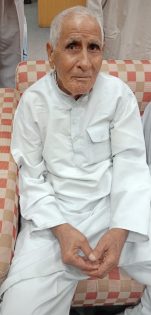
INA Veteran Jagram Yadav, aged 95 years
According to accounts by INA veterans Shri Bhagmal, Shri Parmanand Yadav, and Shri Jagram, the British deceived thousands of Indian soldiers by not informing them that they were to participate in the war. They were taken to Hong Kong and Singapore by deceit. Later, many of them revolted when they came to know the purpose of being ferried to far away lands. Those who revolted were left to die in the ships without food. As per Shri Bhagmal’s account, many Indian soldiers died out of hunger. Shri Bhagmal and many soldiers consumed lime available in the ship, to survive. Many, who could not digest the lime, died.
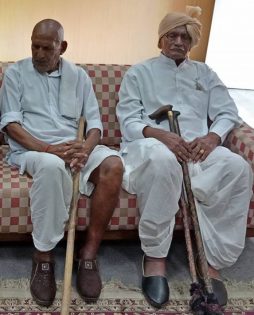
INA Veterans Shri Bhagmal (left), 111 years and Shri Parmanand Yadav 99 years
Three Indians in Singapore took leadership roles to organize the INA at the initial stages, thus laying the foundation of a strong base for Netaji Bose. They were Anand Mohan Sahay, Rash Behari Bose, and Mohan Singh. Anand Mohan Sahay published a newspaper where he voiced the atrocities of British and appealed the Indians settled abroad to unite and fight for the freedom of India. He moved from place to place to spread awareness and to unite the Indians. His wife Mrs. Sahay secretly visited India when Netaji Bose was under house arrest. She met Netaji and convinced him to lead the INA for India’s independence. It was after this meet that Netaji fled from India from his home prison and through different routes finally reached Singapore and Japan. Anand Mohan Sahay’s daughter Asha Sahay was the lieutenant of the Rani Jhansi Regiment of Azad Hind Fauz.
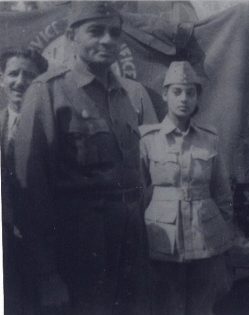
Anand Mohan Sahay with his daughter Lt. Asha Sahay; Image courtesy: Shubham Sharma
Rash Behari Bose became a Japanese citizen in 1923 after marrying a Japanese woman. He was instrumental in persuading the Japanese authorities to stand by the Indian nationalists and support the cause of Indian freedom struggle. Mohan Singh was a temporary captain under British in World War 2 in Malaya. Later he betrayed his oath to the British Crown by supporting the Japanese mission for the freedom of India.

Rash Behari Bose and his wife and Mohan Singh; Images Source: theprint.in and Indianetzone
With Japan’s support, the Provisional Government of Free India had nominal authority of the Andaman and Nicobar Islands including parts of Manipur and Nagaland. And Azad Hind declared war against the Anglo-American allied forces on the Indo-Burma Front. They charged against the British forces in the Imphal-Kohima sector. After defeating the British defences in Kohima, they advanced further towards Moirang. From here they had to retreat owing to compromised supply lines and withdrawal of Japanese forces. Out of 60,000 INA soldiers, 26,000 attained martyrdom in action for the freedom of the country.
To quote Maj Gen GD Bakshi again for those who think INA men were deserters and oath breakers, “You still want to bootlick the Brits as many of our predecessors did – that’s your choice. But please immigrate to Britain before you do that. Not on Indian Soil please – we have surfeit of traitors.”
Featured image courtesy: netaji.org.
Latest posts by manoshi sinha (see all)
- What if Shaikh Paltu had Helped Mangal Panday instead of British? - October 23, 2024
- Shivaleela: Celebration of Shiva in this 21st Century Gurukul - October 23, 2024
- INA Veteran Lt Madhvan Appeals for Installation of Statue of Rash Behari Bose in Delhi - October 23, 2024

